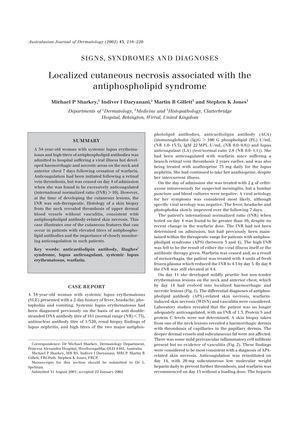Localized Cutaneous Necrosis Associated with the Antiphospholipid Syndrome
July 2002
in “
Australasian Journal of Dermatology
”
antiphospholipid syndrome systemic lupus erythematosus cutaneous necrosis antiphospholipid antibodies warfarin retinal vein thrombosis international normalized ratio thrombosis vasculitis anticoagulation therapy hair loss skin lesions sun protection topical corticosteroids hydroxychloroquine scalp biopsy lymphocytic inflammation lupus panniculitis alopecia alopecia areata APS SLE blood thinners INR blood clots steroids Plaquenil hair thinning skin rashes

TLDR A woman with lupus experienced skin death due to a blood clotting disorder after stopping a blood thinner, which healed with treatment.
In 2002, a 34-year-old woman with systemic lupus erythematosus (SLE) and high levels of antiphospholipid antibodies developed localized cutaneous necrosis after discontinuing warfarin, which she was taking due to a previous retinal vein thrombosis. The necrosis occurred when her international normalized ratio (INR) was below the therapeutic range. A skin biopsy confirmed thrombosis in the upper dermal blood vessels without vasculitis, suggesting the necrosis was related to antiphospholipid antibodies. The patient's skin healed after anticoagulation therapy was resumed. Additionally, the patient experienced hair loss and skin lesions that were initially managed with sun protection and topical corticosteroids. Two years later, new hair loss and skin lesions resolved with hydroxychloroquine treatment. A scalp biopsy revealed lymphocytic inflammation consistent with lupus panniculitis, which was the cause of the alopecia. This case underscores the importance of monitoring anticoagulation in patients with APS and the need for dermatologists to recognize the cutaneous manifestations of APS for proper diagnosis and treatment. It also highlights the necessity of distinguishing lupus-induced alopecia from other types such as alopecia areata.





